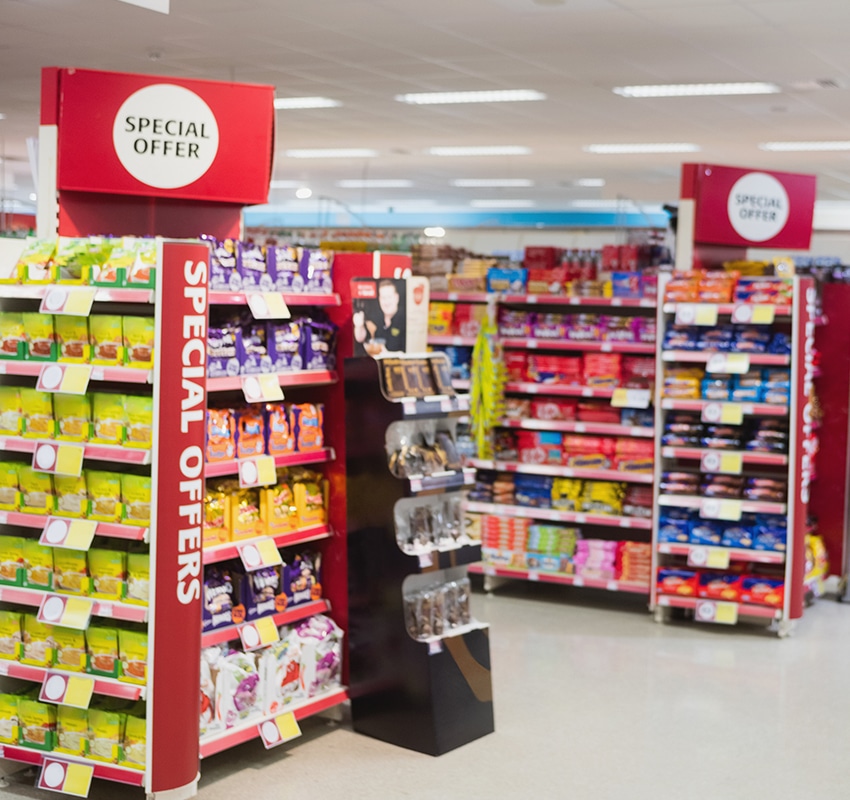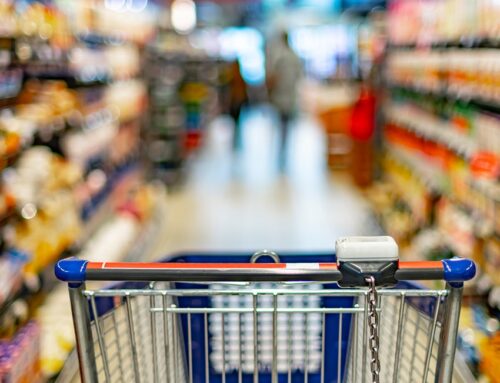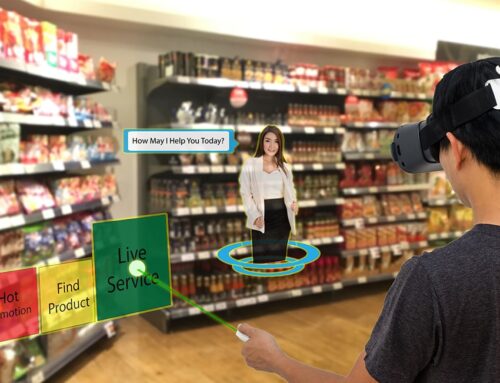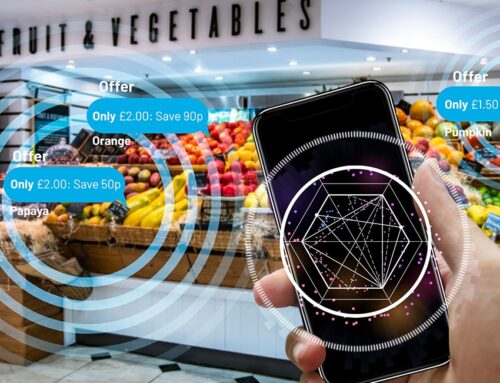10 Innovative Strategies for Supermarket Advertising
To maximize their return on investment, supermarkets need to implement creative marketing strategies that will keep customers coming back. Just two innovative ideas for increasing supermarket advertising efforts include using in-store technology and making the most of social media. A grocery store can create a memorable shopping experience that will have an influence on both existing and potential customers by using these ten efficient approaches.
Key Takeaways
- Boost brand awareness by utilizing social media to advertise products.
- Create engaging content, leverage influencer partnerships, and implement targeted ad campaigns.
- Enhance the in-store experience through interactive displays, eco initiatives & personalized email marketing.
1. Using the Power of Social Media
Social media can be an effective tool for supermarkets to connect with their customers and effectively promote products. Platforms like Facebook, Instagram, and Twitter are all excellent channels to increase engagement, brand awareness, and visibility of new offerings.
Through these platforms, it’s possible to advertise special deals as well as upcoming events at the supermarket or even holiday hours which make up key marketing tactics that help advance overall marketing efforts.
Creating Engaging Content
Supermarket marketing strategies must be effective in order to achieve success. Discounts for products, bulk purchases, and loyalty program members will encourage customers to visit and purchase items. Engaging consumers through contests or incentivizing them with feedback can entice shoppers while providing exclusive rewards for loyal patrons via product demonstrations, visuals, and interactive content on social media is an additional method of rewarding customer commitment.
When creating effective advertising strategies, supermarkets should include promotional discounts as well as persuasive copywriting and alluring imagery that entices potential customers into their stores, improving traffic flow and thereby expanding sales and revenue opportunities.
Influencer Partnerships
Influencer collaborations can be an incredibly transformative means for supermarkets to advertise. Through such partnerships, it’s possible for these stores to reach more people, boost their legitimacy and reputation in the market as well as strengthen brand awareness with results-driven marketing strategy that engages customers through grocery shopping promotions.
Companies can find influencers by looking up relevant hashtags or researching those in their specialized industry using specialized software platforms made for this purpose.
Businesses should set clear goals, give clear instructions, and offer fair compensation when working with these influencers. Together, these elements form an effective strategy that is necessary when trying to persuade customers to visit and shop at your supermarket.
2. Targeted Ad Campaigns
Supermarkets can use social media platforms to reach out to their targeted customer base and boost store traffic. By placing attractive, branded reusable shopping bags near checkout counters in highly visible locations, customers will be drawn into the supermarket for a visit as well as potential purchases. This not only has environmental benefits from lessening plastic bag usage but also strengthens community connections with local artists involved in designing the reusable bags and other business owners nearby.
Supermarkets can deliberately reward loyal customers with unique promotions and discounts, which can build client loyalty and possibly encourage customer retention or business growth overall.
3. Enhancing the In-Store Experience
Creating a positive in-store experience is one of the best ways to draw and maintain customers. By taking initiatives such as designing an inviting atmosphere, playing tasteful music, implementing interactive displays, and emphasizing eco-friendly practices supermarkets can easily create unforgettable shopping experiences.
Additional strategies for enhancing the experience include providing discounted prices through promotional pricing, interacting with customers on social media platforms, displaying branded reusable bags at checkout stands, delivery services, as well as appropriate grocery store background music. These strategies work together to ensure that visitors have an enjoyable experience that they will want to repeat in the future.
Ambiance and Music
When upbeat, recognizable pop music is playing, grocery shopping might go more smoothly and customers can stay in the store longer. It has been observed that it enhances their experience significantly. By carefully curating a musical playlist supermarkets are able to create an atmosphere conducive to encouraging shoppers to take time to explore what they have on offer and increase purchases accordingly. Therefore, the atmosphere produced by thoughtful soundscapes aids in positively influencing customer behavior while also enhancing their shopping experience.
Interactive Displays
Interactive displays are powerful marketing tactics that can attract customers to a supermarket. By implementing entertaining experiences, such as quizzes and games, shoppers will be enticed to visit the store leading towards impulse purchases.
These screens give consumers detailed product information along with visuals and videos of items being sold in order for them to make an informed decision before buying something. Interactive displays help supermarkets promote their offers or discounts which could motivate customers even more when it comes time to purchase items at the checkout line.
4. Eco-Friendly Initiatives
Promoting environmentally friendly practices in supermarket advertising can draw attention from eco-minded buyers and give your store a point of difference compared to other markets. Reusable bag use should be encouraged again, local goods should be purchased, and packaging waste should be decreased.
These actions could increase brand recognition, improve customer satisfaction, and provide benefits like cost savings and community support. Since such initiatives offer so many advantages, success in creating effective retail advertisements depends on them.
5. Personalized Email Marketing
Grocery stores can reap great benefits from personalized email marketing, allowing them to stay in the customers’ minds and entice repeat visits. They can build customer commitment and loyalty by offering customized material that is relevant by leveraging segmentation, targeted campaigns, and client feedback.
There will be a noticeable difference regarding opens/clicks on their messages, translating into increased conversions for business success. This is accomplished by delivering relatable emails that are individually addressed.
Segmentation and Targeting
Segmenting and targeting allow businesses to segment their customer base into smaller groups based on shared traits, which enables them to serve more personalized content. By providing customers with the most relevant data, this marketing strategy boosts response rates and conversions and encourages them to shop at the supermarket more frequently.
Promotional Campaigns
A supermarket can stand out by catering to regional tastes and cultures. You can start advertising campaigns that are based on seasons or regions. For instance, localized social media campaigns or even in-store decorations and banners might be used to promote special offers on relevant products during a local festival. Understanding your target demographic clearly is important before launching any marketing campaigns. Find out their interests, requirements, and behaviors by conducting market research; this information can be vital for effectively personalizing your campaign.
Your campaigns should be multi-channel because today’s consumers are. To reach a larger audience, use a combination of online and offline platforms including social media, email marketing, in-store promotions, and traditional advertising. Integrated campaigns provide a more thorough experience for customers, which increases their conversion potential.
Customers are frequently motivated to act quickly when there is a sense of urgency. Flash sales and time-limited promotions can be excellent ways to increase sales quickly. To build anticipation, make sure the campaign is well publicized in advance. All leading up to more sales & higher customer loyalty levels – especially when you’re able to draw new customers! This is achieved by providing incentives like exclusive discounts or free shipping which makes it easier for people who may not have tried the store before to give them an incentive too!
Customer Feedback
Through the use of surveys, polls, and other customer feedback tactics sent through email, supermarkets can gain useful information to enhance their marketing efforts. This data collected from customers will be used for more targeted emails that respond to individual needs when it comes to grocery shopping. Not only does this create a better experience but also aids in increasing overall satisfaction with products offered by the supermarket itself.
Customer insights are utilized as key elements for refining store offerings along with service quality which contribute significantly towards improving promotional activities conducted by supermarkets.
6. Local Community Engagement
Supermarkets understand that forming a bond with the local community is essential to their marketing strategies. Through sponsoring events, collaborating with local producers, and launching charitable initiatives, supermarkets can cultivate customer loyalty as well as build up favorable brand recognition in the locality.
Engaging with potential customers through local ties not only gives supermarkets the opportunity to grow their base but also aids them in creating a positive image amongst members of the neighborhood.
Sponsor Local Events
Sponsoring local events can be a great way for supermarkets to gain visibility, and strengthen their connection with potential and existing customers, while also demonstrating positive support of the community. Supermarkets could make contributions financially or by offering discounted products to attendees. Such acts would likely result in increased recognition of the brand, improved customer loyalty as well as an uptick in sales.
Support Local Producers
Supermarkets are in a great position to contribute to the economic growth of their local communities by featuring items from nearby producers. Special sections can be created, discounts offered, samples handed out for these products, and campaigns launched that focus on them while tying in influencers or sponsoring events. All this boosts consumer awareness about locally made goods and encourages support towards those creating it.
Charitable Initiatives
When supermarkets donate a portion of their sales or support local events, they are demonstrating corporate social responsibility. This can benefit non-profit organizations by raising funds and creating goodwill for the business through positive media attention. On top of that customers feel satisfied with their purchase which results in increased loyalty towards the supermarket leading to repeated transactions from these customers.
7. Implementing Loyalty Programs
Grocery store marketing strategies often involve establishing loyalty programs to boost repeat business and customer lifetime value. Tiered reward systems, exclusive offers, and personalized rewards entice customers to continue their relationship with the grocery store in order to earn more benefits. As a result, it is beneficial for businesses that want higher levels of customer loyalty and spending over time.
Tiered Rewards System
Supermarkets can promote loyalty and satisfaction by providing customers with a tiered rewards system. Different levels of benefits are made available based on the customer’s spending, offering exclusive discounts, free products, bonus points, or rewards for achieving higher tiers and referrals. Customers have an incentive to spend more in order to progress through reward levels which ultimately increases their loyalty towards the supermarket chain as they gain access to additional benefits.
Exclusive Offers
Loyalty programs can be used to drive repeat business and entice customers to join by offering exclusive discounts, deals, and promotions. In order to increase sales, supermarkets can increase customer loyalty by offering various incentives. Thus improving overall revenue. Loyalty program members benefit from special offers that cannot be accessed elsewhere, making it a win-win situation for both businesses as well as the customers who take part in such benefits.
Personalized Rewards
Tailoring rewards to customer data, such as purchase histories and individual preferences, can bolster loyalty program members’ engagement and satisfaction. This way businesses like supermarkets can foster a stronger connection with their customers by offering tailored rewards that are specifically designed for them which will eventually lead to repeat business opportunities. Personalizing incentives could result in an elevated level of commitment from clients along with amplified gratification overall thus allowing firms the chance to cultivate increased customer loyalty and additional business success.
8. Expanding Online Presence
Making sure that your grocery store has a strong presence on the web is essential to meeting customer needs and preferences. To enhance this, you should consider optimizing your online ordering services and integrating a mobile app for customers’ easy browsing of products. This will give shoppers convenience as well as boost sales opportunities over the internet. Investing in an optimized website can help maximize potential buyers engaging with online shopping from your supermarket business – providing even more growth in e-commerce revenue!
Website Optimization
Maximizing the shop website is essential for offering a flawless user experience, presenting products and offers, as well as streamlining online ordering. Making sure that it’s mobile-friendly with effortless navigation plus attractive visuals are all important steps in optimizing customer satisfaction.
Feature product pages along with advertising banners and videos/pictures can make campaigns noticeable which will lead to increased participation from customers and ultimately more online purchases.
Online Ordering and Delivery
For improved customer satisfaction and increased online sales, supermarkets can offer an easy-to-use ordering process by enabling customers the option of placing orders via their website or a third-party delivery service such as DoorDash, Grubhub, or Uber Eats. Making sure there is a variety of payment options available will streamline this experience for consumers.
Mobile App Integration
Integrating a mobile app into your supermarket’s marketing plan can provide customers with an individualized experience and facilitate the online ordering process. It also offers them exclusive deals, such as discounts or coupons, which encourage repeat purchases and boost sales. By enabling users to create profiles and get tailored recommendations through the application they become more engaged in their shopping journey, thus increasing customer satisfaction levels too.
9. Utilizing In-Store Technology
In-store technology such as digital signage, interactive kiosks, and augmented reality can add to the shopping experience for customers, consequently leading to higher sales. These technologies draw in shoppers’ attention with their engaging interactions which display products that could ultimately lead them to making an impulse purchase.
Digital Signage
Supermarkets can boost sales and engage their customers through the utilization of digital signage. By featuring videos, animations, or interactive displays with dynamic content such as promotions and product information. Supermarkets have an opportunity to grab consumer attention. To further maximize marketing efforts, digital signage also provides a mechanism for targeted advertising that is catered toward the demographics of store customers.
Interactive Kiosks
Interactive kiosks can be a great asset to businesses as they offer customers an interactive experience that will boost customer satisfaction and encourage them to return. Comprehensive product information, such as nutritional facts, ingredients, and pricing are easily accessible through the kiosk interface which also allows orders to be placed quickly and conveniently. As these systems provide tailored recommendations for customers This helps build loyalty with businesses ensuring potential repeat business in the future.
Augmented Reality
Augmented reality in supermarket advertising can provide customers with an engaging and immersive experience. Through the use of AR, consumers are able to explore products interactively and get a realistic feel for them. Which subsequently improves customer satisfaction levels, encourages repeat purchases, and boosts overall engagement.
10. Data-Driven Marketing Decisions
Businesses can strengthen their marketing strategies and maximize ROI through data-driven decisions. By analyzing customer segmentation, market research, and performance tracking information, companies are able to make informed choices while strengthening relationships with customers. This allows them to create more optimized advertising efforts that generate the greatest return on investment possible.
Customer Segmentation
When it comes to effective supermarket marketing strategies, customer segmentation is essential. Supermarkets can customize their campaigns and promotional materials to be more relevant and effective with each different consumer group by segmenting their clients into distinct groups based on shared traits.
Customizing promotions through personalization, segregation, or targeting are all effective strategies that can assist in expanding a company’s target market when focused on certain customers.
Market Research
Market research is essential for supermarkets, as it allows them to identify current trends and opportunities in their marketing strategies. By collecting customer data, competitor information, and assessing the market environment through surveys, focus groups interviews, or observational studies they are able to gain better insights into consumers’ preferences which can then be used when making decisions regarding their marketing efforts. This type of study enables them to optimize those same efforts with greater success.
Summary
In order to stay competitive, supermarkets must use innovative strategies such as utilizing social media platforms and email marketing for personalized campaigns, incorporating loyalty programs that reward customers who return regularly, engaging with the local community in meaningful ways, providing an enhanced shopping experience within the store itself via technology advances – all while making data-driven decisions. This will help you create unique experiences that will keep customers coming back for more.











